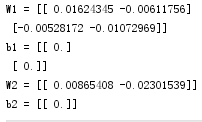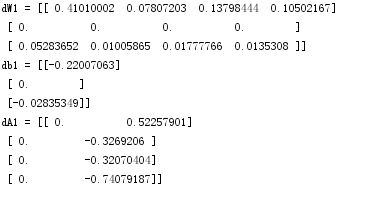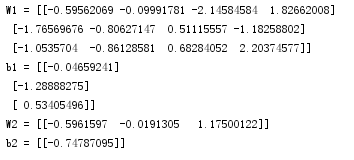吴恩达神经网络与深度学习——深度神经网络习题4
构建DNN架构
a^[l]:第l层的激活函数
w^[l],b^[l]:第l层的参数
x^(i):第i个训练样本
a^[l]_i:第l层第i个神经元的激活函数
包
numpy
matplotlib
dnn_utils
import numpy as np
import h5py
import matplotlib.pyplot as plt
from testCases_v2 import *
from dnn_utils_v2 import sigmoid, sigmoid_backward, relu, relu_backward
%matplotlib inline
plt.rcParams['figure.figsize'] = (5.0, 4.0) # set default size of plots
plt.rcParams['image.interpolation'] = 'nearest'
plt.rcParams['image.cmap'] = 'gray'
%load_ext autoreload
%autoreload 2
np.random.seed(1)
作业大纲
建一个2层NN和一个L层NN
1.初始化参数
2.实现前向传播
实现一个线性部分(Z^[l])
实现激活函数(ReLu/sigmoid)
将前两步结合起来,形成[LINEAR->ACTIVATION]正向传播
复制L-1次,最后一次使用[LINEAR->sigmoid]正向传播
3.计算损失函数
4.实现反向传播
完成反向传播的线性部分
计算激活函数的导数(relu_backward/sigmoid_backward)
结合前两步,形成 [LINEAR->ACTIVATION] 反向传播
复制L-1次,最后一次使用[LINEAR->sigmoid]反向传播
5.更新参数

初始化
2层NN
import numpy as np
def initialize_parameters(n_x, n_h, n_y):
'''
input:
n_x:input layer size
n_h:hidden layer size
n_y:outpou layer size
output:
parameters:which combine W1,W2,b1,b2
W1,b1:1th layer parameters
W1.shape = n_h,n_x
b1.shape = n_h,1
W2,b2:2th layer parameters
W2.shape = n_y,n_h
b2.shape = n_y,1
'''
np.random.seed(1)
W1 = np.random.randn(n_h, n_x) * 0.01
W2 = np.random.randn(n_y, n_h) * 0.01
b1 = np.zeros((n_h, 1))
b2 = np.zeros((n_y, 1))
assert (W1.shape == (n_h, n_x))
assert (W2.shape == (n_y, n_h))
assert (b1.shape == (n_h, 1))
assert (b2.shape == (n_y, 1))
parameters = {
"W1": W1,
"W2": W2,
"b1": b1,
"b2": b2}
return parameters
parameters = initialize_parameters(2,2,1)
print("W1 = " + str(parameters["W1"]))
print("b1 = " + str(parameters["b1"]))
print("W2 = " + str(parameters["W2"]))
print("b2 = " + str(parameters["b2"]))

L层NN
import two_layer_nn
import numpy as np
def initialize_parameters_deep(layer_dims):
'''
input:
layer_dims:python array (list) containing the dimensions of each layer in our network
example:layer_dims = [2,4,1]means it's a 2 layer NN,input layer has 2 units,hidden layer has 4 units,output layer has 1 unit
output:
:parameters: which combines W1,b1,W2,b2,...,WL,bL
W1.shape = n1,n0 b1.shape = n1,1
W2.shape = n2,n1 b2.shape = n2,1
...
WL.shape = nL,nL-1,bL.shape = nL,1
'''
np.random.seed(3)
parameters = {}
L = len(layer_dims)
for i in range(1,L):
parameters["W"+str(i)] = np.random.randn(layer_dims[i],layer_dims[i-1])*0.01
parameters["b"+str(i)] = np.zeros((layer_dims[i],1))
assert (parameters["W"+str(i)].shape == (layer_dims[i],layer_dims[i-1]))
assert (parameters["b"+str(i)].shape == (layer_dims[i],1))
return parameters
parameters = initialize_parameters_deep([5,4,3])
print("W1 = " + str(parameters["W1"]))
print("b1 = " + str(parameters["b1"]))
print("W2 = " + str(parameters["W2"]))
print("b2 = " + str(parameters["b2"]))

前向传播


2层NN
线性部分
def linear_forward(A, W, b):
'''
input:
:param A: input dataset
A.shape = n_x , m
:param W: 1th layer parameters
W.shape = n_h,n_x
:param b: 1th layer parameters
b.shape = n_h,1
return:
:param Z:
Z.shape = n_h,m
'''
Z = np.dot(W,A)+b
assert (Z.shape == (W.shape[0],A.shape[1]))
cache = (A,W,b)
return Z,cache
A, W, b = testCases_v2.linear_forward_test_case()
Z, linear_cache = linear_forward(A, W, b)
print("Z = " + str(Z))
激活函数
import numpy as np
def sigmoid(Z):
"""
Implements the sigmoid activation in numpy
Arguments:
Z -- numpy array of any shape
Returns:
A -- output of sigmoid(z), same shape as Z
cache -- returns Z as well, useful during backpropagation
"""
A = 1/(1+np.exp(-Z))
cache = Z
return A, cache
def relu(Z):
"""
Implement the RELU function.
Arguments:
Z -- Output of the linear layer, of any shape
Returns:
A -- Post-activation parameter, of the same shape as Z
cache -- a python dictionary containing "A" ; stored for computing the backward pass efficiently
"""
A = np.maximum(0,Z)
assert(A.shape == Z.shape)
cache = Z
return A, cache
def relu_backward(dA, cache):
"""
Implement the backward propagation for a single RELU unit.
Arguments:
dA -- post-activation gradient, of any shape
cache -- 'Z' where we store for computing backward propagation efficiently
Returns:
dZ -- Gradient of the cost with respect to Z
"""
Z = cache
dZ = np.array(dA, copy=True) # just converting dz to a correct object.
# When z <= 0, you should set dz to 0 as well.
dZ[Z <= 0] = 0
assert (dZ.shape == Z.shape)
return dZ
def sigmoid_backward(dA, cache):
"""
Implement the backward propagation for a single SIGMOID unit.
Arguments:
dA -- post-activation gradient, of any shape
cache -- 'Z' where we store for computing backward propagation efficiently
Returns:
dZ -- Gradient of the cost with respect to Z
"""
Z = cache
s = 1/(1+np.exp(-Z))
dZ = dA * s * (1-s)
assert (dZ.shape == Z.shape)
return dZ

线性+激活函数
def linear_activation_forward(A_prev, W, b, activation):
'''
input:
A_prev -- activations from previous layer (or input data): (size of previous layer, number of examples)
W -- weights matrix: numpy array of shape (size of current layer, size of previous layer)
b -- bias vector, numpy array of shape (size of the current layer, 1)
activation -- the activation to be used in this layer, stored as a text string: "sigmoid" or "relu"
Returns:
A -- the output of the activation function, also called the post-activation value
cache -- a python dictionary containing "linear_cache" and "activation_cache";
stored for computing the backward pass efficiently
'''
if activation == "sigmoid":
Z,linear_cache = linear_forward(A_prev,W,b)
A,activation_cache= dnn_utils_v2.sigmoid(Z)
elif activation == "relu":
Z,linear_cache = linear_forward(A_prev,W,b)
A,activation_cache = dnn_utils_v2.relu(Z)
assert (A.shape == (W.shape[0],A_prev.shape[1]))
cache = (linear_cache,activation_cache)
return A,cache
A_prev, W, b = testCases_v2.linear_activation_forward_test_case()
A, linear_activation_cache = linear_activation_forward(A_prev, W, b, activation = "sigmoid")
print("With sigmoid: A = " + str(A))
A, linear_activation_cache = linear_activation_forward(A_prev, W, b, activation = "relu")
print("With ReLU: A = " + str(A))

L层NN
# GRADED FUNCTION: L_model_forward
def L_model_forward(X, parameters):
"""
Implement forward propagation for the [LINEAR->RELU]*(L-1)->LINEAR->SIGMOID computation
Arguments:
X -- data, numpy array of shape (input size, number of examples)
parameters -- output of initialize_parameters_deep()
Returns:
AL -- last post-activation value
caches -- list of caches containing:
every cache of linear_relu_forward() (there are L-1 of them, indexed from 0 to L-2)
the cache of linear_sigmoid_forward() (there is one, indexed L-1)
"""
caches = []
A = X
L = len(parameters) // 2 # number of layers in the neural network
# Implement [LINEAR -> RELU]*(L-1). Add "cache" to the "caches" list.
for l in range(1, L):
A_prev = A
### START CODE HERE ### (≈ 2 lines of code)
A, cache = linear_activation_forward(A_prev,
parameters["W" + str(l)],
parameters["b" + str(l)],
activation='relu')
caches.append(cache)
### END CODE HERE ###
# Implement LINEAR -> SIGMOID. Add "cache" to the "caches" list.
### START CODE HERE ### (≈ 2 lines of code)
AL, cache = linear_activation_forward(A,
parameters["W" + str(L)],
parameters["b" + str(L)],
activation='sigmoid')
caches.append(cache)
### END CODE HERE ###
assert(AL.shape == (1,X.shape[1]))
return AL, caches
X, parameters = testCases_v2.L_model_forward_test_case()
AL, caches = L_model_forward(X, parameters)
print("AL = " + str(AL))
print("Length of caches list = " + str(len(caches)))

代价函数
def compute_cost(AL, Y):
"""
Implement the cost function defined by equation (7).
Arguments:
AL -- probability vector corresponding to your label predictions, shape (1, number of examples)
Y -- true "label" vector (for example: containing 0 if non-cat, 1 if cat), shape (1, number of examples)
Returns:
cost -- cross-entropy cost
"""
m = Y.size
cost = -1/m * np.sum(Y*np.log(AL)+(1-Y)*np.log(1-AL))
assert (cost.shape == ())
return cost
Y, AL = testCases_v2.compute_cost_test_case()
print("cost = " + str(compute_cost(AL, Y)))

反向传播
2层NN
线性部分
def linear_backward(dZ, cache):
"""
Implement the linear portion of backward propagation for a single layer (layer l)
Arguments:
dZ -- Gradient of the cost with respect to the linear output (of current layer l)
cache -- tuple of values (A_prev, W, b) coming from the forward propagation in the current layer
Returns:
dA_prev -- Gradient of the cost with respect to the activation (of the previous layer l-1), same shape as A_prev
dW -- Gradient of the cost with respect to W (current layer l), same shape as W
db -- Gradient of the cost with respect to b (current layer l), same shape as b
"""
A_prev ,W , b = cache
m = dZ.shape[1]
dW = 1/m * np.dot(dZ,A_prev.T)
db = 1/m * np.sum(dZ,axis=1,keepdims=True)
dA_prev = np.dot(W.T,dZ)
assert (dA_prev.shape == A_prev.shape)
assert (dW.shape == W.shape)
assert (db.shape == b.shape)
return dA_prev,dW,db
dZ, linear_cache = testCases_v2.linear_backward_test_case()
dA_prev, dW, db = linear_backward(dZ, linear_cache)
print ("dA_prev = "+ str(dA_prev))
print ("dW = " + str(dW))
print ("db = " + str(db))

扫描二维码关注公众号,回复:
3926261 查看本文章


激活函数+线性部分
# GRADED FUNCTION: linear_activation_backward
def linear_activation_backward(dA, cache, activation):
"""
Implement the backward propagation for the LINEAR->ACTIVATION layer.
Arguments:
dA -- post-activation gradient for current layer l
cache -- tuple of values (linear_cache, activation_cache) we store for computing backward propagation efficiently
activation -- the activation to be used in this layer, stored as a text string: "sigmoid" or "relu"
Returns:
dA_prev -- Gradient of the cost with respect to the activation (of the previous layer l-1), same shape as A_prev
dW -- Gradient of the cost with respect to W (current layer l), same shape as W
db -- Gradient of the cost with respect to b (current layer l), same shape as b
"""
linear_cache, activation_cache = cache
if activation == "relu":
### START CODE HERE ### (≈ 2 lines of code)
dZ = relu_backward(dA, activation_cache)
dA_prev, dW, db = linear_backward(dZ, linear_cache)
### END CODE HERE ###
elif activation == "sigmoid":
dZ = sigmoid_backward(dA, activation_cache)
dA_prev, dW, db = linear_backward(dZ, linear_cache)
return dA_prev, dW, db
AL, linear_activation_cache = linear_activation_backward_test_case()
dA_prev, dW, db = linear_activation_backward(AL, linear_activation_cache, activation = "sigmoid")
print ("sigmoid:")
print ("dA_prev = "+ str(dA_prev))
print ("dW = " + str(dW))
print ("db = " + str(db) + "\n")
dA_prev, dW, db = linear_activation_backward(AL, linear_activation_cache, activation = "relu")
print ("relu:")
print ("dA_prev = "+ str(dA_prev))
print ("dW = " + str(dW))
print ("db = " + str(db))

L层NN
def L_model_backward(AL, Y, caches):
"""
Implement the backward propagation for the [LINEAR->RELU] * (L-1) -> LINEAR -> SIGMOID group
Arguments:
AL -- probability vector, output of the forward propagation (L_model_forward())
Y -- true "label" vector (containing 0 if non-cat, 1 if cat)
caches -- list of caches containing:
every cache of linear_activation_forward() with "relu" (it's caches[l], for l in range(L-1) i.e l = 0...L-2)
the cache of linear_activation_forward() with "sigmoid" (it's caches[L-1])
Returns:
grads -- A dictionary with the gradients
grads["dA" + str(l)] = ...
grads["dW" + str(l)] = ...
grads["db" + str(l)] = ...
"""
grads = {}
L = len(caches) # the number of layers
m = AL.shape[1]
Y = Y.reshape(AL.shape) # after this line, Y is the same shape as AL
# Initializing the backpropagation
### START CODE HERE ### (1 line of code)
dAL = -np.divide(Y, AL) + np.divide((1 - Y), (1 - AL))
### END CODE HERE ###
# Lth layer (SIGMOID -> LINEAR) gradients. Inputs: "AL, Y, caches". Outputs: "grads["dAL"], grads["dWL"], grads["dbL"]
### START CODE HERE ### (approx. 2 lines)
current_cache = caches[-1]
grads["dA" + str(L)], grads["dW" + str(L)], grads["db" + str(L)] = two_layer_nn.linear_activation_backward(dAL, current_cache,
activation="sigmoid")
### END CODE HERE ###
for l in reversed(range(L - 1)):
# lth layer: (RELU -> LINEAR) gradients.
# Inputs: "grads["dA" + str(l + 2)], caches". Outputs: "grads["dA" + str(l + 1)] , grads["dW" + str(l + 1)] , grads["db" + str(l + 1)]
### START CODE HERE ### (approx. 5 lines)
current_cache = caches[l]
dA_prev_temp, dW_temp, db_temp = two_layer_nn.linear_activation_backward(grads["dA" + str(l + 2)], current_cache,
activation="relu")
grads["dA" + str(l + 1)] = dA_prev_temp
grads["dW" + str(l + 1)] = dW_temp
grads["db" + str(l + 1)] = db_temp
### END CODE HERE ###
return grads
AL, Y_assess, caches = testCases_v2.L_model_backward_test_case()
grads = L_model_backward(AL, Y_assess, caches)
print ("dW1 = "+ str(grads["dW1"]))
print ("db1 = "+ str(grads["db1"]))
print ("dA1 = "+ str(grads["dA1"]))

更新参数
def update_parameters(parameters, grads, learning_rate):
"""
Update parameters using gradient descent
Arguments:
parameters -- python dictionary containing your parameters
grads -- python dictionary containing your gradients, output of L_model_backward
Returns:
parameters -- python dictionary containing your updated parameters
parameters["W" + str(l)] = ...
parameters["b" + str(l)] = ...
"""
L = len(parameters)//2
for i in range(1,L):
parameters["W"+str(i)] = parameters["W"+str(i)]-learning_rate*grads["dW"+str(i)]
parameters["b"+str(i)] = parameters["b"+str(i)]-learning_rate*grads["db"+str(i)]
assert (parameters["W"+str(i)].shape ==grads["dW"+str(i)].shape )
assert (parameters["b" + str(i)].shape == grads["db" + str(i)].shape)
return parameters
parameters, grads = testCases_v2.update_parameters_test_case()
parameters = update_parameters(parameters, grads, 0.1)
print ("W1 = "+ str(parameters["W1"]))
print ("b1 = "+ str(parameters["b1"]))
print ("W2 = "+ str(parameters["W2"]))
print ("b2 = "+ str(parameters["b2"]))
